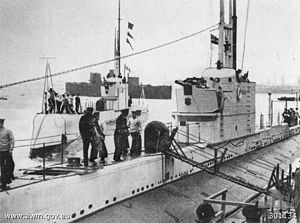This article includes a list of references, related reading, or external links, but its sources remain unclear because it lacks inline citations. (February 2013) |
The Odin-class submarine (or "O class") was a class of nine submarines developed and built for the Royal Navy (RN) in the 1920s. The prototype, Oberon, was followed by two boats originally ordered for the Royal Australian Navy, but transferred to the RN in 1931 because of the poor economic situation in Australia, and six modified boats ordered for the RN. Three modified boats were built for the Chilean Navy as the Capitan O'Brien-class submarines in 1929.
 Oxley and Otway
| |
| Class overview | |
|---|---|
| Name | Odin class or O class |
| Operators | |
| Preceded by | L class |
| Succeeded by | Parthian class |
| Subclasses | Capitan O'Brien class |
| In commission | 22 July 1927–1945 |
| Completed | 9 |
| Lost | 6 |
| Retired | 3 |
| General characteristics | |
| Type | Submarine |
| Displacement | |
| Length |
|
| Beam |
|
| Propulsion |
|
| Speed |
|
| Range |
|
| Test depth | 300 ft (91.4 m) |
| Complement | 54 |
| Sensors and processing systems | ASDIC |
| Armament |
|
Design edit
The class was built to replace the ageing L-class submarines which did not have adequate endurance for use in the Pacific Ocean. These boats were theoretically able to dive to 500 feet (150 m), though none were formally tested beyond 300 feet (91 m). Armament consisted of eight 21-inch (533 mm) torpedo tubes (6 bow, 2 stern) and one 4-inch (102 mm) gun. The boats were of a saddle tank type with fuel carried in riveted external tanks. These external tanks proved vulnerable to leaking after depth charge damage, thus betraying the position of the submarine. These boats were the first British submarines fitted with Asdic and VLF radio which could be used at periscope depth.
Boats edit
| Boat | Builder | Launched | Fate |
|---|---|---|---|
| Oberon (ex-O1) | Chatham Dockyard | 24 September 1926 | Scrapped, 1945 |
| Boat | Builder | Launched | Fate |
|---|---|---|---|
| Otway | Vickers, Barrow | 7 September 1926 | Scrapped, 1945 |
| Oxley | Vickers, Barrow | 29 September 1926 | Sunk in a friendly fire incident by Triton near Norway, 10 September 1939 |
| Boat | Builder | Launched | Fate |
|---|---|---|---|
| Odin | Chatham Dockyard | 5 May 1928 | Sunk by Italian destroyer Strale in the Gulf of Taranto, 14 June 1940 |
| Olympus | William Beardmore and Company | 11 December 1928 | Mined off Malta, 8 May 1942 |
| Orpheus | William Beardmore and Company | 26 February 1929 | Sunk by Italian destroyer Turbine in the Mediterranean, 19 June 1940 |
| Osiris | Vickers, Barrow | 19 May 1928 | Scrapped, September 1946, Durban. |
| Oswald | Vickers, Barrow | 19 June 1928 | Sunk by Italian destroyer Ugolino Vivaldi off Calabria, 1 August 1940 |
| Otus | Vickers, Barrow | 31 August 1928 | Scuttled, September 1946, off Durban. |
References edit
- Akermann, Paul (2002). Encyclopaedia of British Submarines 1901–1955 (reprint of the 1989 ed.). Penzance, Cornwall: Periscope Publishing. ISBN 1-904381-05-7.
- Bagnasco, Erminio (1977). Submarines of World War Two. Annapolis, Maryland: Naval Institute Press. ISBN 0-87021-962-6.
- Colledge, J. J.; Warlow, Ben (2006) [1969]. Ships of the Royal Navy: The Complete Record of all Fighting Ships of the Royal Navy (Rev. ed.). London: Chatham Publishing. ISBN 978-1-86176-281-8.
- Chesneau, Roger, ed. (1980). Conway's All the World's Fighting Ships 1922–1946. Greenwich, UK: Conway Maritime Press. ISBN 0-85177-146-7.
- McCartney, Innes (2006). British Submarines 1939–1945. New Vanguard. Vol. 129. Oxford, UK: Osprey. ISBN 1-84603-007-2.